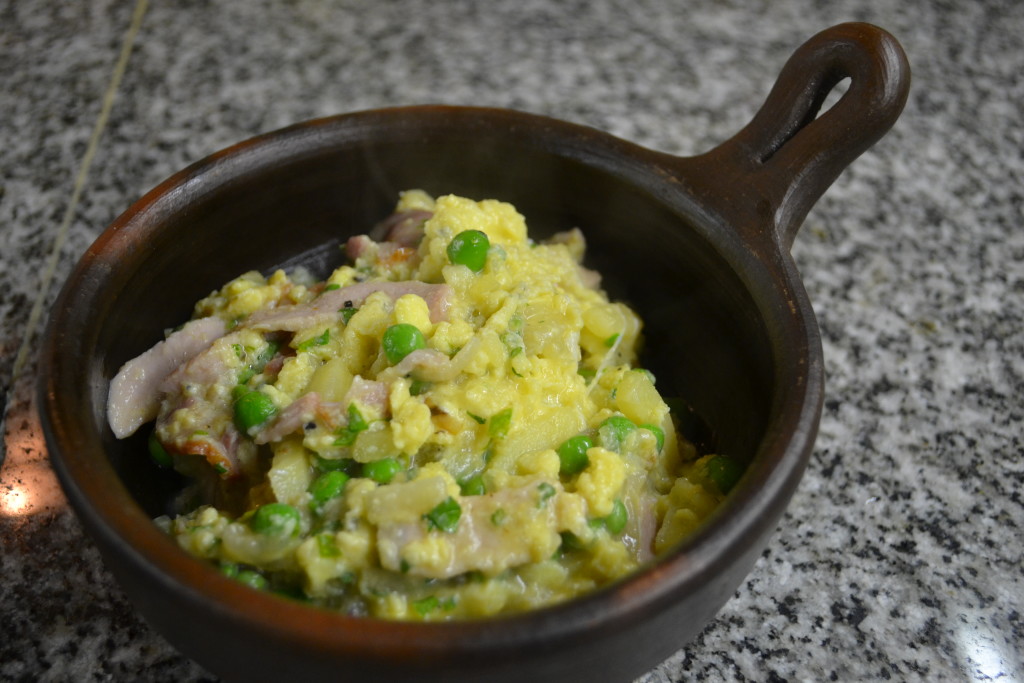On Sunday supplement
Food and Wine
Sometimes when a recipe is named after someone famous the story is relatively well known. Other times, it’s not, as in the case of the origins of one of Argentina’s iconic dishes, the revuelto gramajo, or “Gramajo’s scramble”. Not only does the legend of the dish have more than one version, but two different Gramajos as the possible origin. At its most basic, the dish is a plate of scrambled eggs with ham, onions, and fried potatoes.
First off, there’s Colonel Artemio Gramajo, adjutant to General Julio Roca during the late 1870s campaign to conquer the “desert”. The colonel, a roly poly sort, was a bit of a gourmand, a bit of a dandy, and, apparently, a fairly accomplished cook. There are three versions of his part of the legend. The most common is that prior to heading out into the battlefield he’d been accustomed to starting his days with a couple of fried eggs, a slab of ham, and some potato and onion hash browns. Preparing all of the items in a tent became a bit of a chore, but being unwilling to give up his beloved morning platter, he fried up the onions and potatoes in a skillet, threw in some chopped up ham, and scrambled in a couple of eggs. Not as pretty, but got the job done.
Version two of the story is similar, but asserts that he put it together for Roca’s breakfast preferences. And, version three has it that this all happened post-war in 1880, when he was ensconced at El Club del Progreso, and regularly insisted on preparing his own breakfast – one day deciding that the detail work of separate cooking of the components was just too much to take on, and, voila!
Bringing in a different Gramajo, Arturo, a socialite, a touch of playboy, later married with children and city superintendent of Buenos Aires. The story is that he was in Paris, staying at the Hotel Ritz, and one day just insisted on preparing his own breakfast, basically throwing together a scramble of whatever looked good sitting on the counter. While it’s not impossible that a 20-something Arturo would have been cavorting about in Paris in the early 1880s he wasn’t yet a particularly well known figure in Argentine society. Given that the revuelto was all the rage in the late 1880s and early 1890s, and has continued to be a staple of local cuisine since, it just seems unlikely that something a kid threw together one morning in a Paris hotel after a night of carousing would become a dining hit back home within moments. I’m not going to say it couldn’t be so, but to me it makes more sense that the influence of military leaders like Roca and Artemio G would have had that impact on their return from the campaign. As to which of the three Artemio stories is the most likely, I think we’ll never know.
As to the dish itself, the traditional deep fried potatoes, butter browned onions, cooked or cured ham and eggs, is basically a heart attack on a plate. Continuing on our quest to lighten things up a bit, here’s our Revuelto Gramajo 2.0, for two.
6 eggs, beaten
1 medium onion, thinly sliced
1 medium potato, peeled and cut in thick matchsticks
100 grams cooked fresh or frozen peas
200 grams roast pork loin, sliced in strips
3 tablespoons olive oil
200 ml low salt vegetable stock
6-8 stalks parsley, chopped
salt and pepper
Between the fat of the butter and ham and high levels of salt in the latter, there’s a lot to love and a lot to lighten. In a frying pan, put the stock, potatoes and onions and cook over low heat until all the liquid is absorbed and the vegetables are soft, about 30 minutes. Add the olive oil, turn up the heat, and stirring gently, lightly brown them. Add the remaining ingredients, a pinch of salt and a few grinds of pepper, reduce the heat and, mixing it all together well, cook until the eggs have just barely set.
A series of recipes and articles that I started writing for the Buenos Aires Herald Sunday supplement, Food & Wine section, at the beginning of 2012. My original proposal to them was to take local favorite dishes and classics and lighten them up for modern day sensibilities. We’re not talking spa or diet recipes, but at the very least, making them healthier in content, particularly salt, fat and portion size. As time went by, that morphed into a recipe column that, while emphasizing food that is relatively “good for you”, wasn’t necessarily focused on local cuisine. At the beginning of 2013 I decided to stop writing for them over some administrative issues, but it was fun while it lasted.
